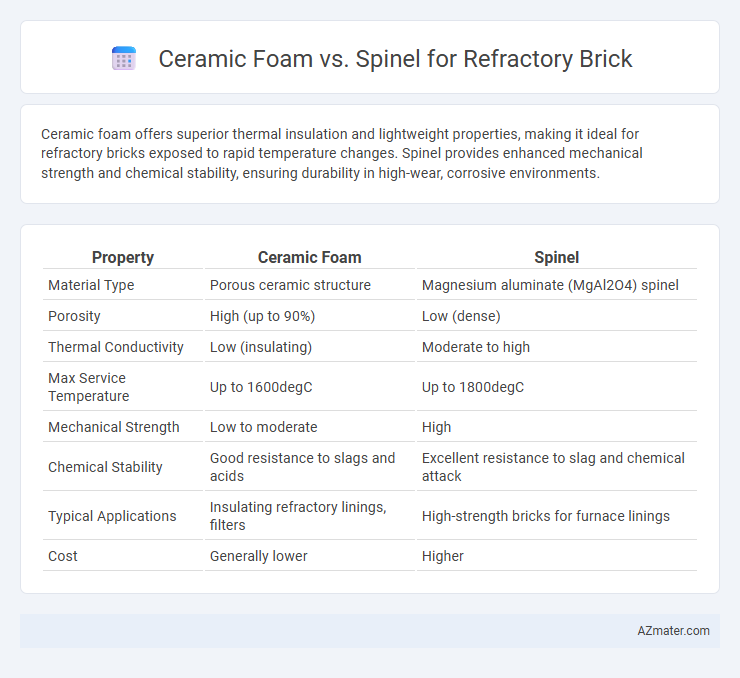Ceramic foam offers superior thermal insulation and lightweight properties, making it ideal for refractory bricks exposed to rapid temperature changes. Spinel provides enhanced mechanical strength and chemical stability, ensuring durability in high-wear, corrosive environments.
Table of Comparison
| Property | Ceramic Foam | Spinel |
|---|---|---|
| Material Type | Porous ceramic structure | Magnesium aluminate (MgAl2O4) spinel |
| Porosity | High (up to 90%) | Low (dense) |
| Thermal Conductivity | Low (insulating) | Moderate to high |
| Max Service Temperature | Up to 1600degC | Up to 1800degC |
| Mechanical Strength | Low to moderate | High |
| Chemical Stability | Good resistance to slags and acids | Excellent resistance to slag and chemical attack |
| Typical Applications | Insulating refractory linings, filters | High-strength bricks for furnace linings |
| Cost | Generally lower | Higher |
Introduction to Refractory Brick Materials
Refractory bricks are essential materials designed to withstand high temperatures and harsh chemical environments in industrial furnaces and kilns. Ceramic foam offers lightweight, porous structure with excellent thermal insulation and shock resistance, while spinel-based bricks provide superior mechanical strength and resistance to slag corrosion due to their stable magnesium aluminate composition. Selection between ceramic foam and spinel refractory bricks depends on specific furnace conditions, balancing thermal insulation requirements with mechanical durability and chemical stability.
Overview of Ceramic Foam in Refractories
Ceramic foam in refractory bricks offers superior thermal insulation due to its interconnected porous structure, which significantly reduces heat transfer and enhances energy efficiency in high-temperature applications. Its lightweight nature combined with excellent mechanical strength provides durability and resistance to thermal shock, making it ideal for furnaces and kilns. The material's chemical stability under extreme conditions ensures long service life and reliability compared to traditional dense refractory bricks like Spinel.
Spinel: Properties and Applications
Spinel refractory bricks exhibit exceptional thermal stability, high mechanical strength, and excellent resistance to slag corrosion, making them ideal for use in high-temperature industrial furnaces and metallurgical processes. Their chemical composition, primarily magnesium aluminate (MgAl2O4), imparts superior resistance to thermal shock and oxidation compared to ceramic foam counterparts, which are more porous and less durable under extreme conditions. Spinel bricks are widely applied in steelmaking ladle linings, glass furnaces, and cement kilns, where their longevity and performance significantly enhance operational efficiency.
Thermal Performance Comparison
Ceramic foam refractory bricks exhibit superior thermal insulation due to their high porosity, reducing heat transfer and enhancing energy efficiency in high-temperature applications. Spinel refractory bricks provide excellent thermal stability and resistance to thermal shock, maintaining structural integrity under rapidly fluctuating temperatures. The choice between ceramic foam and spinel depends on balancing insulation properties with mechanical strength requirements for specific industrial environments.
Mechanical Strength and Durability
Ceramic foam refractory bricks exhibit high porosity that enhances thermal insulation but generally results in lower mechanical strength compared to dense spinel bricks, which offer superior compressive strength and resistance to mechanical wear. Spinel refractory bricks, containing magnesium aluminate (MgAl2O4), demonstrate excellent durability in high-temperature environments due to their strong chemical stability and resistance to slag corrosion. While ceramic foam excels in reducing thermal conductivity, spinel bricks provide better long-term structural integrity and mechanical performance under thermal cycling and mechanical stress.
Resistance to Chemical Corrosion
Ceramic foam refractory bricks exhibit superior resistance to chemical corrosion due to their high porosity and alumina-silica matrix, which effectively withstands acidic and basic slags in industrial furnaces. Spinel refractory bricks, composed mainly of magnesium aluminate (MgAl2O4), provide excellent chemical stability against molten metals and aggressive slags, especially in high-temperature environments. When comparing both, ceramic foam offers enhanced chemical corrosion resistance in slag-rich atmospheres, while spinel demonstrates better performance against metal attack and thermal shock.
Energy Efficiency in High-Temperature Environments
Ceramic foam refractories exhibit superior energy efficiency in high-temperature environments due to their porous structure, which significantly reduces thermal conductivity and enhances insulation performance. Spinel refractories, while offering excellent chemical stability and mechanical strength, generally have higher thermal conductivity, resulting in greater heat loss compared to ceramic foam. Selecting ceramic foam over spinel bricks can lead to reduced energy consumption and improved thermal management in industrial furnaces and kilns.
Cost Analysis: Ceramic Foam vs Spinel
Ceramic foam refractory bricks typically offer lower initial material costs compared to spinel bricks, making them a budget-friendly option for applications requiring high porosity and thermal insulation. Spinel bricks, though more expensive upfront due to their superior mechanical strength and chemical resistance, often provide longer service life and reduced maintenance costs in aggressive environments. Evaluating the total cost of ownership, including lifecycle durability and performance under specific operating conditions, is essential to determine the most cost-effective choice between ceramic foam and spinel refractories.
Suitability for Industrial Applications
Ceramic foam exhibits superior thermal insulation and shock resistance, making it ideal for high-temperature industrial furnaces and reactors requiring rapid heat transfer and energy efficiency. Spinel refractory bricks offer excellent chemical stability and mechanical strength, suitable for aggressive environments such as steelmaking and glass manufacturing where corrosion resistance is critical. Selection depends on specific operational demands, with ceramic foam favored in insulation-intensive processes and spinel preferred for structural durability under extreme chemical exposure.
Future Trends in Refractory Brick Technology
Ceramic foam and spinel are pivotal materials shaping future trends in refractory brick technology due to their exceptional thermal stability and corrosion resistance. Advancements in nano-engineering and additive manufacturing are enhancing the microstructure of ceramic foam bricks, improving porosity control for better insulation and energy efficiency. Spinel-based refractories are being optimized for higher mechanical strength and slag resistance, enabling superior performance in extreme industrial environments such as steelmaking and cement production.

Infographic: Ceramic foam vs Spinel for Refractory brick
 azmater.com
azmater.com